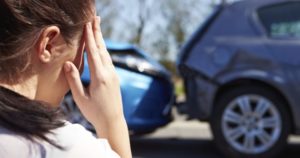When you’re out on the road, whether commuting to work, going to the grocery store, or taking a road trip, you should always be on the lookout for other drivers, especially inexperienced teen drivers.
On top of inexperience, teens think they are invincible—that nothing bad can happen to them. In many cases, they learn the hard way when they crash the vehicle and injure themselves and others or kill others on the road. Their parents learn that their teen wasn’t listening to their lectures if the teen dies in the accident. Our New York car accident lawyers have experience handling a wide range of car accident claims involving teenage drivers
Teens make plenty of deadly mistakes on the road, including the following:
Risk Taking
 You know that you had to try anything and everything when you were a teen. You were invincible. Today’s teens are the same way. Teens will take more risks, including driving under the influence, driving distracted, and speeding. According to the Centers for Disease Control (CDC), about 2,400 teens between the ages of 13 and 19 died in car accidents. About 258,000 went to the emergency room for accident-related injuries during the same period.
You know that you had to try anything and everything when you were a teen. You were invincible. Today’s teens are the same way. Teens will take more risks, including driving under the influence, driving distracted, and speeding. According to the Centers for Disease Control (CDC), about 2,400 teens between the ages of 13 and 19 died in car accidents. About 258,000 went to the emergency room for accident-related injuries during the same period.
Vehicle crash fatalities involving teens aged 15 through 19 cost about $4.8 billion in medical expenses and lost wages that same year.
Not Wearing a Seatbelt
Many teenagers killed in car accidents were not wearing seatbelts. When your teen goes out on the road, ensure that they know to wear a seatbelt. While it’s not a good idea for teens to drive with friends in the car, if they do, they should ensure that everyone in the vehicle has their seatbelt on before starting the vehicle.
Speeding
It’s easy to get into driving, especially when listening to music and getting lost in the music. When you do that, you don’t realize that your foot has developed a mind of its own and is getting closer and closer to the floor—and the vehicle you are driving is going faster and faster.
Teens are also more likely to try to keep up with other speeding drivers, especially on highways. Teach teens who are new to driving to leave early and take their time. It’s better to be late than never arrive at your destination.
Driving With Friends
Try to discourage teens from driving with others in the vehicle. It’s often difficult as they want to spend time with each other, going to parties, the movies, out to eat, or even picking up friends on the way to school. However, the fatal crash risk increases for each teen passenger in the vehicle when a teen is driving.
Driving Distracted: Cell Phones
Teens always have their faces in a cell phone or tablet. Most have an active social life. It’s too tempting to answer the phone when they get a call or a text while driving. Even hands-free devices are dangerous to adults, never mind teens. Although your hands are on the wheel, your mind is not on the road. According to the National Highway Traffic Safety Administration (NHTSA), over 3,100 people die in distracted driving accidents per year.
Night Driving
Night driving is more dangerous for teens and adults as it is more challenging to see road signs and others on the road. The Children’s Hospital of Philadelphia Research Institute found that teens had a 19 percent higher risk of wrecking from 9:00 p.m. until midnight and a 16 percent higher risk of wrecking from 6 p.m. until 9 p.m.
Nighttime driving—from 6 p.m. until 5:59 a.m.—resulted in accident fatalities increasing by 12 percent over a year. That is for all ages. However, it is more challenging for teens to drive at night because of inexperience.
Driving Under the Influence
 Driving under the influence of alcohol or drugs is illegal if you have a blood alcohol level of 0.08 or higher. In some states, the level is much lower for teens. However, alcohol and illicit drugs are not the only things that can impair a person’s ability to drive safely—including teens. Prescription medications can also affect your ability to drive safely.
Driving under the influence of alcohol or drugs is illegal if you have a blood alcohol level of 0.08 or higher. In some states, the level is much lower for teens. However, alcohol and illicit drugs are not the only things that can impair a person’s ability to drive safely—including teens. Prescription medications can also affect your ability to drive safely.
Teach teens to always check their prescribed medications before getting behind the wheel. If you make it a habit of getting teens to check now, they’ll do it when you are not around and when they become adults.
As for driving under the influence, if a teen must drink or use drugs while out, encourage them to stay where they are for the night or to call home for a ride. Explain to them that it is better to suffer your disappointment than never see them again.
Succumbing to Peer Pressure
Teens might say no to their friends, but kids are insistent. Eventually, your teen’s hounding friends will get them to do something she doesn’t want to do, such as driving with too many in the vehicle, driving under the influence, or breaking curfew to stay out later. Any of those activities could result in an accident, especially when combined with driving after dark.
It’s always a good idea to make sure teens know that driving at night is dangerous because of their inexperience and because adults on the road after dark also have a hard time seeing.
Being Overconfident
Inexperience and overconfidence easily lead to crashes, especially when an inexperienced teen runs into unexpected or unfamiliar situations. Talk to your teens about safe driving practices on a regular basis and monitor your teen’s driving for at least a year or more after they get their license.
Driving Distracted: Radios, iPods, and other Music-Listening Devices
Driving without music is usually boring, especially for a teen. However, it is better that they learn to drive without the distraction of music. Adjusting the radio is one of the most common distractions for drivers, especially teens. They can easily concentrate on the song that is playing instead of giving the road their full attention. Even worse is taking their eyes off the road to change the channel or skip a song on their device.
Car Accident Injuries
Accident injuries range from bruises and scratches to death depending on several factors, including speed, the size of the vehicles involved in the accident, and how the vehicles collide. While one party might come out of the accident with bruises and cuts, the other could die. Dealing with the death of another person is hard enough for adults, but when a teen causes a fatal accident, they might have a harder time recovering psychologically.
When teaching your teen how to drive, take the opportunity to explain some of the injuries they could sustain—or cause to the other driver, including:
- Bumps, bruises, scratches, cuts, and scrapes.
- Infections of open wounds that require hospitalization.
- Strains and sprains.
- Pulled and torn muscles and other soft tissue injuries.
- Face and eye injuries.
- Head, neck, and shoulder injuries.
- Traumatic brain injuries.
- Internal injuries.
- Simple and compound fractures.
- Thermal and chemical burns.
- Road rash.
- Crushed bones and other crush injuries.
- Back and spinal cord injuries.
- Amputation of a digit or limb.
- Psychological injuries, such as post-traumatic stress disorder and anxiety.
- Infections of open wounds from surgeries to repair accident injuries.
Accident injuries could also exacerbate existing illnesses and injuries. The at-fault driver is also responsible for paying for additional medical expenses, pain, and suffering for worsening existing issues. You would not have the extra expenses and suffering if not for the defendant’s actions or inactions.
Recovering Damages After an Accident With a Teen
In many cases, the teen is on the parent’s vehicle insurance. If the teen was driving without insurance, the parents could end up paying for the teen’s mistake, depending on the circumstances.
Those injured in a car accident could recover three types of damages: Compensatory damages in the form of economic damages and non-economic damages, and punitive damages. Compensatory damages make the injured person financially whole again, while the court orders a defendant to pay punitive damages as a punishment for their grossly negligent behavior.
While most accident victims can recover economic damages, only those who lost a loved one or whose injuries caused long-term or permanent disabilities usually recover non-economic damages.
Economic Damages
Sometimes referred to as special damages, economic damages include:
- Medical expenses, including doctor’s appointments; surgeries; follow-up appointments; upgrades to your home, including grab bars, handrails, wheelchair ramps, and widened doorways; upgrades to your vehicles, including wheelchair ramps or lifts, and hand controls; prescriptions, ambulatory aids, and various therapies, including cognitive, psychological, physical, and occupational therapy.
- Income, including those you lose from the time of the accident until the time you settle or win a trial award. You could also recover the loss of future earning capacity for any difference in the amount you earned prior to the accident to what you make if you are able to go back to work. If your injuries prevent you from going back to work, you could recover an amount comparable to what you earned until you retire. If you can work part-time or take a full-time job that doesn’t pay as much because your injuries won’t allow you to do your old job, you could recover partial loss of future earning capacity.
- Personal property, including your vehicle and anything of value inside the vehicle that was damaged or destroyed in the accident.
- Death-related expenses, including cremation expenses, burial and funeral expenses, certain probate court costs, and probate attorney’s fees and costs.
Non-Economic Damages
Sometimes referred to as general damages, non-economic damages include:
- Pain and suffering, including emotional distress.
- Loss of quality of life if you have to make life-long changes, such as taking prescriptions or using ambulatory aids.
- Loss of companionship if you can no longer participate in or enjoy family outings, activities, and events.
- Loss of consortium if you can no longer have a physical relationship with your spouse.
- Loss of use of a body part, such as a foot or an arm.
- Loss of use of a bodily function, such as your bladder or eyesight.
- Inconvenience if you have to hire someone to do the chores you normally do, such as house cleaning, grocery shopping, lawn maintenance, and home repair and maintenance.
- Disfigurement or excessive scarring.
- Amputation of a limb or digit.
Punitive Damages
Some states allow you to collect punitive damages. However, the court must award compensatory damages in order for you to collect punitive damages. Because of this, the trial is bifurcated—into two parts. During the second part, you will have the same judge and jury for punitive damages.
Since punitive damages are to punish the defendant for his grossly negligent behavior, this award is not to make you whole again. That is what compensatory damages are for. The court reviews the defendant’s actions and inactions to make a determination of whether they constitute gross negligence.
Working With an Insurance Company
 Whether the teen driver is on their parent’s insurance policy or has his own, you don’t want to give the insurance company any information about the accident, as it will use tricks to lay the blame at your feet in order to deny your claim. Barring that, the insurance company will do what it can to offer you the least amount possible since insurance claim payouts reduce the company’s profits.
Whether the teen driver is on their parent’s insurance policy or has his own, you don’t want to give the insurance company any information about the accident, as it will use tricks to lay the blame at your feet in order to deny your claim. Barring that, the insurance company will do what it can to offer you the least amount possible since insurance claim payouts reduce the company’s profits.
If you report the accident yourself, only give the insurance representative your name, contact information, date and location of the wreck, and your attorney’s contact information. If you retain a car accident lawyer soon enough, your injury attorney can notify the insurance company.
Once you say something to the insurance company, you can’t take it back—and if you say the wrong thing, it could affect the amount of compensation you receive.
